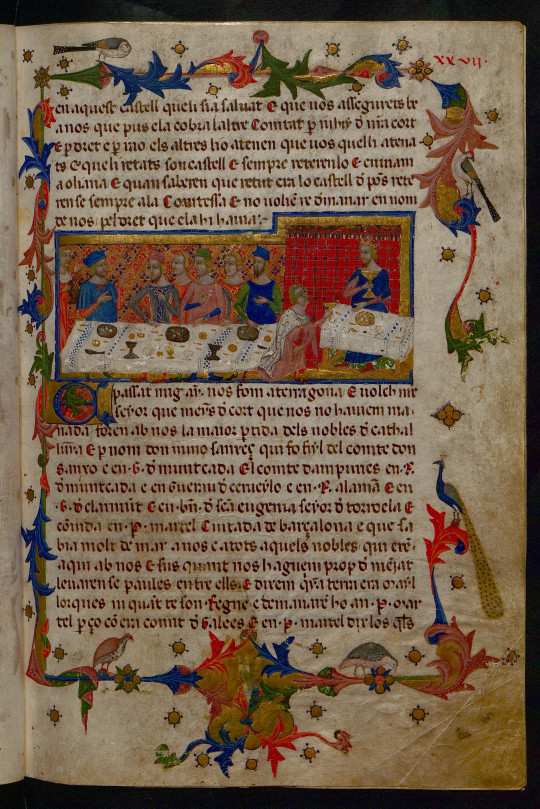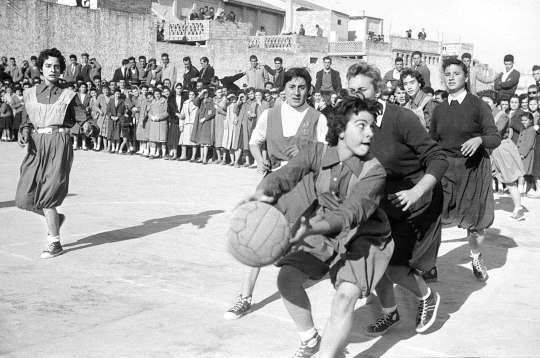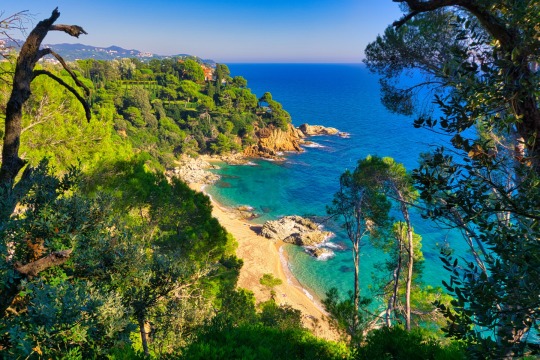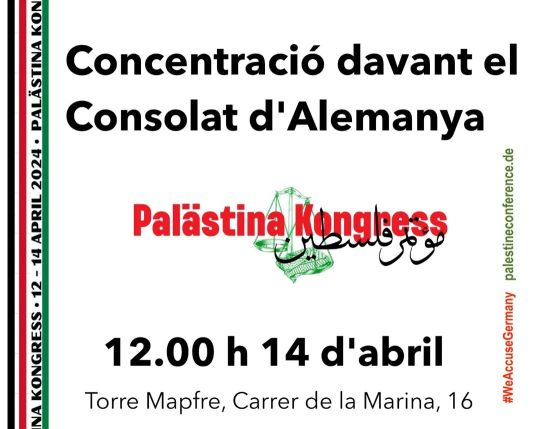Text
Video by Daily Catalan on Instagram:
"Pa de pessic" (pinch bread) is a typical Catalan dessert that doesn't require many ingredients but has an incredible taste (as if you were biting into a cloud!).
You can find the recipe (in Catalan and English) in her Instagram clicking the link.
#pa de pessic#menjar#recepta#recipe#video recipe#dessert#bake#baking#bakery#cake#spongy cake#cooking#cooking video#cooking sounds#cooking asmr#recipes#sweet#yummy#delicious#food
55 notes
·
View notes
Text
Sóller, Mallorca (Balearic Islands).
Video by aufilduglobe on Instagram.
#sóller#mallorca#illes balears#train#tram#travel#travel photography#reels#europe#wanderlust#explore#aesthetic#traveling#vacation#trains#rail#transportation
35 notes
·
View notes
Text



Chronicle of the King James I (Jaume I) of Catalonia-Aragon (1208-1276). Manuscript copy written in the year 1343 in Poblet, Catalonia. University of Barcelona library.
James I's chronicle titled Llibre dels fets ("Book Of The Deeds") is regarded as the first secular chronicle-autobiography attributed to a Christian king.
#història#jaume i#arts#literatura#history#literature#art history#illuminated manuscript#medieval#middle ages#1200s#13th century#books#books and reading#reading#historical#artifact#europe#catalonia#cultures
41 notes
·
View notes
Note
hello! since you seem to know bit about football, do you know if valencia is also considered a catalan/valencian club? do they also celebrate their heritage like girona and barça, or are they españolistas like espanyol? :o
With my limited knowledge about football, Valencia has a more Spanish fanbase, and the more Valencianist people are usually fans of Levante. (Despite the names).
6 notes
·
View notes
Text
People dancing a sardana in la Bisbal de l'Empordà's town square, Catalonia. Video by Amics de la Sardana Terranostra.
This is sardana, a type of music and dance from Catalonia often considered Catalonia's national dance.
The music for the sardanes is always played by a cobla, a specific music ensamble consisting of 11 musicians playing 12 instruments with a predominance of wind instruments.
There are many songs of the sardana genre, all of which share the same beat. For this reason, the same handful of dance steps can be used for all songs. The dance is easy on purpose, so that everyone can join. It consists of two basic steps called the “short step” and the “long step”, and it’s always danced in circle holding hands.
The circle represents friendship, harmony, fraternity and solidarity among everyone who joins to hold hands.


People dancing sardanes in Northern Catalonia. Photos from the article “Sardane, une ronde fraternelle en Pays Catalan” by Béatrice Bantegny on Visit PO.
In the late 19th century, authorities (government and religious) condemned the sardana for being immoral because it meant that men and women who aren’t relatives were holding hands, but it was too popular to control it. During Franco’s fascist dictatorship of Spain (1939-1978), some sardana songs were banned because they were considered too Catalan (one of the pillars of Spanish fascism was/is Catalanophobia, the dictatorship wanted to exterminate the Catalan language, culture, and identity and impose the Spanish one instead).
But sardanes kept being danced through all of it and nowadays you can still find that a cobla plays in most towns during its local festivities, and everyone can join and dance. Though in most of Catalonia this dance is now associated with elderly people, in the Comarques Gironines it's particularly beloved. In the Empordà area, you can often find it in summer evenings.
#sardana#sardanes#música#dansa#arts#catalunya#folk dance#folk music#cobla#traditions#culture#cultures#europe#travel#wanderlust#la bisbal d'empordà
41 notes
·
View notes
Text
Every time I make a post with photos from Northern Catalonia —saying in the post's text the location and that it's in Northern Catalonia—, many of the people who reblog it tag it as #spain. Some day you're all going to get in trouble with the French government! /j
#some have the idea ''catalonia is spain'' so ingrained in their brains that they even apply it to a place that has never been in spain#and that has been ruled by France for the last 400 years#catalunya nord
66 notes
·
View notes
Text

A room in Can Papiol house-museum in Vilanova i la Geltrú (Penedès, Catalonia).
Since the year 1790 and throughout the 19th century, this was the home of one of the wealthiest families in the small city of Vilanova i la Geltrú: the Papiol family, who owned many vineyards around the city. The house has preserved its 19th century interiors, and nowadays it's a house-museum that allows visitors to see what a 19th century upper class family home was like.
The house includes a library with about 6,000 books written between the 16th and the 19th centuries, as well as a music room, a billiard room, a ballroom where the family hosted music parties and literary meetings, a dining room, the bedrooms, a small private chapel, the servants' rooms, areas for servants to do domestic work and for farmers to do their work, stables, and a little Romantic garden.
Photo by mirades_nostres on Instagram.
#vilanova i la geltrú#catalunya#fotografia#catalonia#palace#europe#interior#interiors#luxury#curators on tumblr#travel photography#elegant#elegance#photography#wanderlust#museum#manor house#historical#19th century#18th century
111 notes
·
View notes
Text
1947-1963: Everyday life in Alginet, a town in the Valencian Country.
All these photos were taken by Ismael Latorre Mendoza and are part of his archive available online.

Workers, 1947.

Orange pickers, 1948.

Going to get water from the fountain, 1949. Before running water was available in houses, going to the public fountain to fetch water was part of the domestic labour that women did every day.

Washing clothes in the wash basin, 1950.

Laying the sweet potatoes, 1951.

The photographer Laura Canet Lozano organizing photos in the studio, 1956.


Women playing basketball, 1958.

Work, 1959.

Workers sorting tomatoes in the Alginet cooperative, 1963.
Lastly, this one is not from Alginet but the nearby town Picassent, but it’s part of the same archive.

Onion pickers near Torre d’Espioca. Picassent, 1947. Here they have stopped working and are posing for the photo, but picking onions is a very harsh job, physically demanding because onions (like potatoes) grow at ground level, meaning that the workers have to work with their backs bent or on their knees.
Once again, if someone tries to convince you that women historically haven't worked outside of doing domestic labour at home, they're wrong and probably trying to sell you something.
#història#alginet#picassent#país valencià#fotografia#ismael latorre mendoza#historical photos#vintage photography#1940s#1950s#1960s#1940s photography#1950s photography#working class history#women in history#women's history#rural life#rural#farm#farmcore
40 notes
·
View notes
Photo

Cheek-kissing as a form of greeting throughout the world (and number of kisses given)
by mexidominicarican8
765 notes
·
View notes
Text
Recomano moltíssim llegir aquest article de l'historiador David Garrido sobre la Segona República espanyola i la seva catalanofòbia i projecte supremacista espanyol.
#història#coses de la terra#català#catalunya#països catalans#segona república#república#segunda republica
36 notes
·
View notes
Photo

Mediterranean coast near Lloret de Mar (Comarques Gironines, Catalonia).
Photo from Lloret Turisme on Facebook.
#lloret de mar#catalunya#fotografia#costa brava#natura#catalonia#travel#sea#beach#mediterranean#coast#travel photography#europe#blue#green#landscape#beautiful places#aesthetic#nature
89 notes
·
View notes
Note
I'm so happy to know you're actually an historian on top of holding that account for the community.🫶
I wanted to ask if you knew some ressources that covered what were different historic fashion in the different Catalan Countries, on different eras and centuries?
My main institute for research and learning is too limited on the subject, so I got redirected to online libraries.
Hi! 😁 Sorry it took me some days to answer, I've been very busy and I was waiting to get a moment to answer this from my computer because adding links from the app is a pain.
(This is secondary but first of all I wanted to say I'm actually an archaeologist and not a historian, I left that ask without specifying what I had studied in relation to history because I don't want to give much information about myself online lol, but I don't want to give wrong credentials either.)
I can give very limited information about this because it's not my area of study, sorry. I'm assuming for your blog description that the resources can be in Catalan, am I right? (because I don't know anything in English about this)
My first thought was the Virtual Museum of Fashion of Catalonia. They have digitalized pieces from different collections around the country. You can browse them by many different labels. But most of them are from the 18th century to nowadays, very few are older than that.
Then my second thought was that the collection Barcelona 1700 surely had one tome dedicated to clothing, and of course they do! It's this book:

Barcelona 1700 is a collection of books about different topics of life in the Early Modern Period in Barcelona, each of them written by historians (or other scholars) specialized in that particular topic. If you're looking for 17th and early 18th centuries, you'll find it here.
You can also check past exhibits from the Valencian Silk Museum and you can find some information in the website of the Garnet Institute (Northern Catalonia).
For the 20th and 21st century, there are many more things. You can check the collection of the Design Museum or the Foundation Antoni de Montpalau which specializes in preserving fashion from the 20th century. And for an overview of seamstresses and fashion in the 20th century, there's this past exhibit from the Catalonia History Museum that continues to be available on their website: Moda i modistes.
If you look for specific time periods, you can probably find more articles or other sources of reliable information. I've checked to see if anything would come up with a quick search on Google Scholar and I found this PhD thesis titled "L'art de la indumentària a la Catalunya del segle XIV", this other PhD thesis titled "La indumentaria señorial femenina catalana del siglo XV y su reflejo en el arte", or this article "La indumentària tradicional d'Eivissa segons les aquarel·les de Joan d'Ivori", "Pasado de moda: una serie de ilustraciones de la indumentaria popular valenciana". I also found this article titled "Definició de dues tipologies de vestit a través del seu ús històric: la indumentària d'arrel tradicional i el vestit d'inspiració internacional" that cites many other books that could be useful to you: Indumentaria tradicional by Joan Amades (of course, how could Amades not have covered everything!), La indumentària civil catalana: segles XIII-XV by Isidre Marangues, Indumentària tradicional del Pallars by Ramon Violant i Simorra, El vestit tradicional d’Amposta. La seva època by Màrius Lopez Albiol, etc.
I don't know what level of analysis and accuracy you're going for, but maybe you can find it useful to take a look at historical recreation societies. Most of them here are from the Baroque period or the Civil War, but you can find them throughout all the Catalan Countries (various Miquelets groups in the Valencian Country and Catalonia come to mind, or the Le Temps du Costume Roussillonais in Northern Catalonia which reaches until the 1910s).
If there's any specific period of history that you're looking for, I can try to find more about that. All the articles I've linked in this post are open, so you don't need to access it through a university or research institution. I hope it's useful!
20 notes
·
View notes
Text

Demà a Barcelona. Convoquen Comunitat Palestina a Catalunya i Prou Complicitat amb Israel.
Not a good look when you refuse a famous plastic surgeon and genocide survivor entry to your country with history like Germany's.... lol.
6K notes
·
View notes
Text



The Dipòsit de les Aigües Library, Universitat Pompeu Fabra, Barcelona, Catalonia.
This library is set up in a 19th-century water reservoir located in the heart of Barcelona. After 100 years of different uses -old people's home, storage for the fire brigade, car park for the local police department, archive for the Court of Justice- it became property of the Pompeu Fabra University in 1992. Since then, it's the university's library.
Photos by Arq Foto, Burçin Yildirim on Flickr, and The ISA Journal.
#barcelona#catalunya#arquitectura#fotografia#library#architecture#19th century#academia aesthetic#dark academia#light academia#libraries#reading#books#bookworm#catalonia#europe#travel#wanderlust#traveling
173 notes
·
View notes
Text

Macarelleta
by sir20 for menorca-sir20
84 notes
·
View notes
Text
You're in for a big surprise about these adaptations! With an unexpected apparition of... the Nazis.
As context for people who might not know, Terra Baixa is one of the most iconic plays in Catalan theatre. In English, it's usually translated as Marta of the Lowlands. It premiered in 1896.
There have been at least 8 film adaptations of Terra Baixa made in various countries (1907 Spain, 1913 Argentina, 1914 USA, 1922 Germany, 1940/1944 Germany, 1950 Mexico, 1982 Catalonia, and 2011 Catalonia). It has also been adapted into 3 operas (La catalane by the French composer Ferdinand Le Borne in 1907, Tiefland by the Scottish composer Eugen d'Albert and German librettist Rudolf Lothar in 1903, and a third Catalan production from the 1990s).
You might be thinking: what's will all this German stuff? Germany 1940-1944?? Leni Riefenstahl??? Yes, my friends. You're about to hear something weird.
Àngel Guimerà (author of Terra Baixa) is famous for his works being explicitly against racism and against religious discrimination (that's Mar i cel's whole point), and denouncing the unfair gender-based violence that women go through such as domestic abuse, rape from men who abuse their social situation (such as bosses) and lack of freedom to take decisions over their lives and, more generally, the control that landowners have over workers (Terra Baixa). The topic of migration and culture mixing also comes up often in his work, which makes sense considering that Guimerà himself was from a mixed Canarian-Catalan family and grew up in the Canary Islands before moving to Catalonia. And, of course, he's also known for his defense of Catalan language and rights for Catalan people, becoming one of the main representatives of political Catalanism, one of the main enemies of Spanish fascism.
So it will come as a shock to anyone familiar with his work to hear that Leni Riefenstahl (a Nazi collaborator) directed a movie version of Terra Baixa.
You're probably thinking "what the fuck? How is that possible when Terra Baixa denounces situations that Nazis were in favour of?", and it's definitely a weird movie. To begin with, they had no idea about (nor interest in) where the play is set (the rural Pyrenee mountains of Catalonia), instead choosing to replace it with a stereotypical Spanish (Andalucía) setting and cultural aesthetic, which they created through casting Romani people that were later sent to concentration camps. So that's a shitty start.
The reason why it resonated with them was the contraposition of Terra Alta ("highland") and Terra Baixa ("lowland"). The play follows the story of a shepherd boy named Manelic who grew up in the "high land", up in the mountains, isolated without knowing many other humans. He is innocent and naïve, and doesn't conceive that people have bad intentions. One day, Manelic is contacted by a rich man from the town in the plane under those mountains (the Lowland). This rich man is Sebastià, the owner of the mill where the Lowland's population works. Sebastià proposes Manelic marry a girl named Marta, who is one of the workers in Sebastià's mill. Manelic immediately falls in love with Marta, and accepts. Of course, nobody asks Marta about this because this is a contract between two men, and so the marriage is set. What Manelic didn't know is the reason why Sebastià proposed this: Sebastià has been taking advantage of Marta and sexually abusing her since she was of young age, using the fact that he's the landowner and a respected man, and she's a much younger working-class girl who depends on him to make a living. Despite owning the land, Sebastià is also in debt, and for this reason he is preoccupied with marrying a rich heiress, but everyone has heard the rumours that Marta is his mistress and so he can't find any respectable (=wealthy) family who will marry their daughter to him. To solve this problem, he decides to marry Marta to someone else and end the rumour, and thus he brings some naïve fool who has no idea of what's going on to be used in his scheme and marry him to Marta in the eyes of the public.
Manelic only finds out about this in his wedding night when Marta, terrified and traumatized, tells him that she doesn't love him and that she refuses to sleep with him. She explains that she did not consent to this marriage, that Sebastià forced her to marry Manelic, and explains how she has been at the mercy of Sebastià all these years, and how she blames Manelic for joining this scheme to clean Sebastià's image after everything he has done to her. Thus, the plot of the story is how Manelic, who comes from the idealistic and naïve Highlands, comes to know about the horrible conditions, the terror, the oppression, and the violence that routinely goes on in the Lowlands. Throughout the story, all the workers laugh at Manelic for being so naïve that he doesn't realize the role he's playing in Sebastià's scheme, but Manelic ends up learning of what happens and swears to leave the Lowland, that he considers a horrible world of lies. Marta, realizing Manelic's pure heart and real respect for her, falls in love with him, and they both decide to escape to the idyllic Highland. However, Sebastià finds out and locks Marta in his mill. The play ends with a fight to death between Manelic and Sebastià, until Manelic manages to kill him and proclaims "I've killed the wolf!", a sentence that has become the most iconic phrase in the history of Catalan theatre.
As you can see, the story is a critique of the conditions that allow these abuses to happen, particularly of "caciquism" which was the majoritary economical-political system in the rural areas of the Iberian peninsula, including Catalonia, at the time when the play was written. The same critiques of Sebastià's power over his agriculture workers under caciquism can be applied to factory owners to the proletariat in industrialized areas as well. And, sadly, Marta's situation of gender-based violence rings true in both of those settings as well as our modern society. The contrast between the ideal Highland (a good-hearted, honest place) and the corrupt Lowland (where exploitation and materialism has degraded its inhabitants into cruel people) is present throughout the play, and it's precisely what caught the attention of Nazi sympathisers.
Instead of understanding this as a critique of hierarchies and how they create the perfect conditions to allow the abuse perpetrated by those above, they saw this story as the contraposition between the "ideal national past", a perfect and pure rural world that never existed, vs the corrupt modern civilization. The same "reject modernity, embrace tradition" that neo-nazis still parrot today, accompanied by their white families with stay-at-home wives (potential Martas! same as her, without their own means to escape if the situation gets bad, at the mercy of their husbands who hold absolute economical and social power over them).
Of course, the Nazis didn't propose anything that would solve those problems, they only pointed at them to blame them on "the decline of Germanic civilization", Jewish people, communists, etc. In fact, Nazi proposals exacerbate the problem. They are Sebastià (though in this case, the wolf killed himself 🤭). But we all know the Nazis aren't exactly bright, to put it softly.
So, yeah. Sorry for this massive tangent lmao, but I love Terra Baixa and I find this such a fascinating topic.
Hey @useless-catalanfacts I just learned that a century ago Terra Baixa got so famous in the international scene that an opera was made in Germany, and also films in the same country and the US!!
Do you know anything about that?? 👀👀
#terra baixa#btw El Búnquer de Catalunya Ràdio tenen un episodi sobre la Leni Riefenstahl que parlen d'això!#àngel guimerà#teatre#literatura#arts
61 notes
·
View notes
